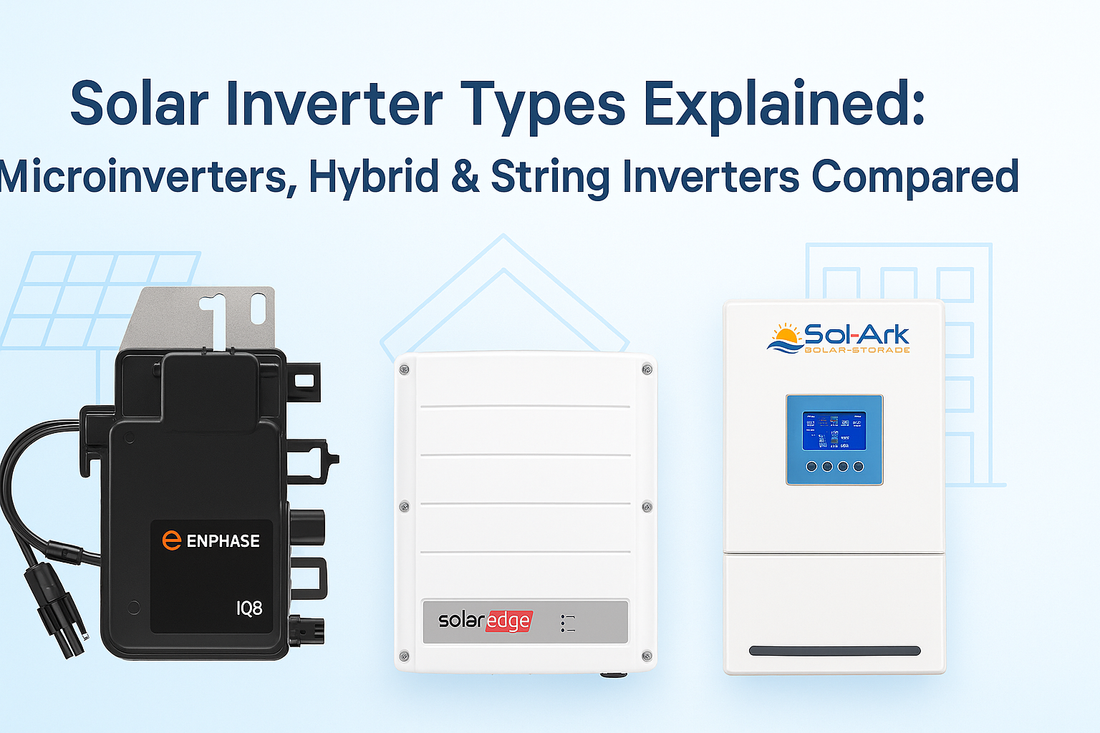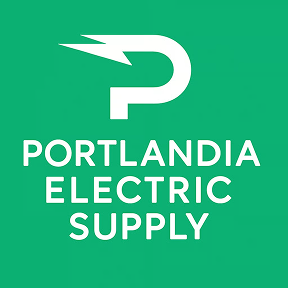
Solar Inverter Types Explained: Microinverters, Hybrid & String Inverters Compared
Share
Solar Inverter Microinverter vs Hybrid vs String: Key Differences Compared
As the world increasingly turns to renewable energy solutions, understanding the components of a solar energy system becomes essential for anyone looking to harness solar power. Among these components, solar inverters hold a pivotal role. They are the unsung heroes of solar panel systems, converting the direct current (DC) electricity generated by solar panels into alternating current (AC) power that can be used in homes. Choosing the right type of solar inverter is crucial for maximizing the efficiency and reliability of your solar power system.
Understanding Solar Inverters
What is a Solar Inverter?
A solar inverter is a specialized power conversion device that is integral to any solar power system. Its primary function is to convert the DC electricity produced by solar panels into AC electricity, which is the form of power used by most household appliances. Without this conversion, the energy harnessed from solar panels would be unusable in a home setting. In essence, the solar inverter is the bridge between the solar array and the home, allowing the flow of usable solar energy. Thus, it stands as one of the most critical components in a rooftop solar installation.
How Solar Inverters Work
Solar power inverters operate by transforming the DC electricity generated by solar panels into AC electricity. This conversion process is necessary because the DC power, although generated efficiently by solar cells, is not directly compatible with the electrical grid or household appliances. By converting DC to AC, solar inverters enable the solar energy system to integrate seamlessly with the home’s electrical system. This conversion also allows for excess power to be fed back into the grid, potentially earning credits for the homeowner. The inverter's ability to manage this conversion is crucial for optimizing the power output of the solar panel system.
Importance of Solar Panel Inverters
Solar panel inverters are indispensable for anyone looking to go solar. They not only convert solar panels into AC electricity but also act as the control center for the solar installation, managing power flow and ensuring maximum power efficiency. Without a solar inverter, the DC power from a solar array would remain untapped and unusable for standard household appliances or for export to the utility grid. In essence, no inverter means no practical way to benefit from solar panels. Thus, the inverter’s role in a solar energy system is as significant as that of the solar panels themselves, making it a crucial consideration in any solar investment.
Types of Solar Inverters
String Inverter
String inverters, sometimes referred to as central inverters, are the most common type of solar inverter used in residential solar power systems. This inverter type is particularly suitable for solar panel systems with uniform sunlight exposure. In a string inverter system, multiple solar panels are connected in series, forming a string, which is then linked to one centralized inverter.
| Feature | Description |
|---|---|
| Function | Converts DC power from panels into AC power for home use. |
| Advantages | Simplicity and efficiency make them popular for straightforward installations. |
They are ideal for installations where all panels have the same orientation and receive equal sunlight exposure, ensuring consistent power output.
Hybrid Inverter
The hybrid inverter is a versatile type of solar inverter that combines the functionalities of a traditional solar inverter with those of a battery inverter. This makes it an excellent choice for solar energy systems that incorporate battery storage.
| Feature | Benefit |
|---|---|
| Compatibility | Works seamlessly with both grid-tied systems and standalone solar power systems |
| Functionality | Manages energy flow from solar panels into the battery pack and converts it to AC power |
They are particularly beneficial for homeowners looking to maximize self-consumption of solar energy and provide backup power during outages. As the solar energy landscape evolves, hybrid inverters are becoming increasingly popular due to their adaptability to different solar energy system configurations and their ability to optimize power use efficiently.
Micro Inverter
Unlike string inverters, micro inverters are small units installed at or near each individual solar panel, allowing for the conversion of DC power to AC power directly at each panel. This decentralized approach means that the performance of each solar panel is optimized independently, making micro inverters a suitable option for installations with varying panel orientations and shading issues. Micro inverters offer the flexibility to easily expand the solar array by adding additional panels as needed. This type of inverter is especially beneficial for complex roof structures or installations where each solar panel might receive different amounts of sunlight. By converting power at the panel level, micro inverters help maximize the overall power output of the solar system, ensuring each panel operates at its peak efficiency.
Choosing the Right Solar Inverter
Factors to Consider
When choosing the right solar inverter for your home solar system, several factors should be considered to ensure optimal performance and cost-effectiveness. Consulting with an expert solar team can provide valuable insights into selecting the best inverter type for your specific needs. Factors such as the size of your solar array, the typical sunlight exposure, and your energy consumption patterns play a crucial role in determining the most suitable inverter option. Professional solar panel installers can help assess your goals and recommend a solar inverter type that balances cost with efficiency, ensuring you receive the maximum power output from your solar power system.
Maximum Power Output
Understanding the maximum power output of a solar inverter is essential for matching the inverter to your solar panel system's capacity. Inverter manufacturers specify the input energy their products can process, which directly influences the performance of your solar installation. Choosing an inverter with a power output that aligns with your solar panels' capacity ensures that your system operates efficiently, without energy being wasted. Selecting an inverter with the appropriate maximum power output can help optimize the overall effectiveness of your solar energy system, ensuring that it meets your household's energy demands.
Solar Energy Needs
The size and capacity of your solar inverter should be aligned with your home's energy needs. Typically, the solar inverter's maximum capacity is rated to match or slightly exceed your estimated annual electricity consumption. This ensures that your solar power system can support your energy requirements effectively, without overburdening the inverter. By carefully considering your solar energy needs and the size of the inverter, you can create a balanced and efficient solar power system that provides reliable energy for your home. Choosing the right inverter helps optimize the return on your investment in solar energy, making it a critical decision in the solar installation process.
Innovations in Solar Inverter Technology
Power Optimizers
Power optimizers represent a significant advancement in solar inverter technology, acting as a bridge between string inverters and microinverters. These devices are installed at the individual panel level, ensuring that each solar panel operates at its peak efficiency by modifying the electrical output before sending it to a central inverter. This setup allows for the maximization of power output from each panel, even in conditions where shading or panel orientation may vary. By optimizing the performance of individual solar panels, power optimizers help increase the overall efficiency of a solar energy system, making them an attractive option for those seeking enhanced performance and reliability in their solar installations.
Battery Storage Solutions
Battery storage solutions have revolutionized the way solar power systems operate by providing a means to store excess energy generated during the day for use at night or during outages. This integration allows solar inverters to draw from stored solar energy, ensuring a continuous power supply regardless of solar panel production. With the addition of solar batteries, homeowners can optimize their energy consumption, reduce reliance on the grid, and increase energy independence. This innovation is particularly beneficial for those living in areas with frequent power outages or for individuals aiming to maximize their self-consumption of solar energy. Battery storage solutions enhance the versatility and resilience of home solar systems, offering a reliable backup in times of need.
Future Trends in Solar Power Inverters
As solar technology continues to evolve, future trends in solar power inverters are likely to focus on improved efficiency, integration with smart home systems, and enhanced grid interaction. Innovations may include more advanced power optimizers, hybrid inverters with better battery management capabilities, and inverters with built-in artificial intelligence to optimize energy use dynamically. Additionally, the development of more compact and cost-effective inverters could make solar power systems more accessible to a broader audience. These trends indicate a shift towards more intelligent, adaptable, and user-friendly solar energy systems that cater to the growing demand for sustainable energy solutions.
Conclusion
Recap of Different Types of Solar Inverters
The solar power industry offers a variety of inverter technologies to accommodate diverse energy needs and system configurations. The four key types of solar inverters include string inverters, microinverters, power optimizers, and hybrid inverters. Each of these technologies provides unique advantages.
| Inverter Type | Advantages |
|---|---|
| String Inverters | Simplicity and cost-effectiveness |
| Microinverters & Power Optimizers | Panel-level optimization |
| Hybrid Inverters | Ability to integrate seamlessly with battery storage systems |
Understanding these different types of solar inverters is crucial for selecting the right technology that aligns with specific solar energy goals and system requirements.
Final Thoughts on Choosing Solar Panel Inverters
Choosing the right solar panel inverter is a critical step in designing an effective and efficient home solar power system. Prospective solar adopters should consider factors such as energy consumption patterns, roof configuration, shading, and the potential for future expansion. For those looking to simplify the decision-making process, utilizing tools like a free solar savings calculator can provide insights into potential savings and the most suitable inverter options. By carefully evaluating these factors and consulting with solar professionals, homeowners can ensure they select the best inverter that maximizes their solar power investment and supports their long-term energy needs.
